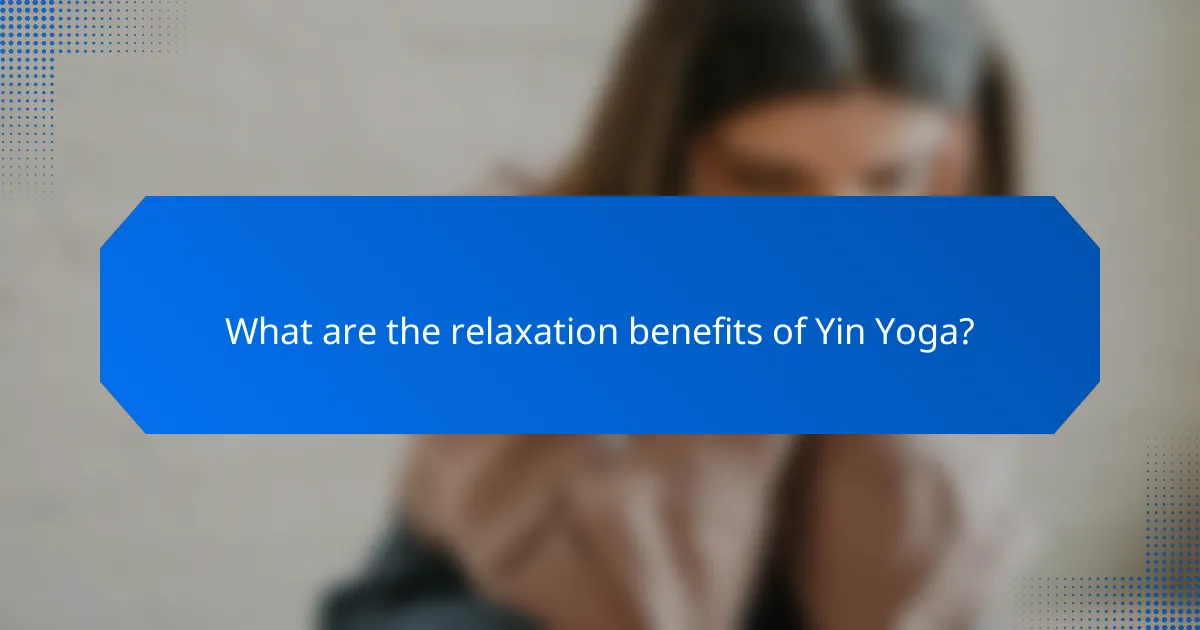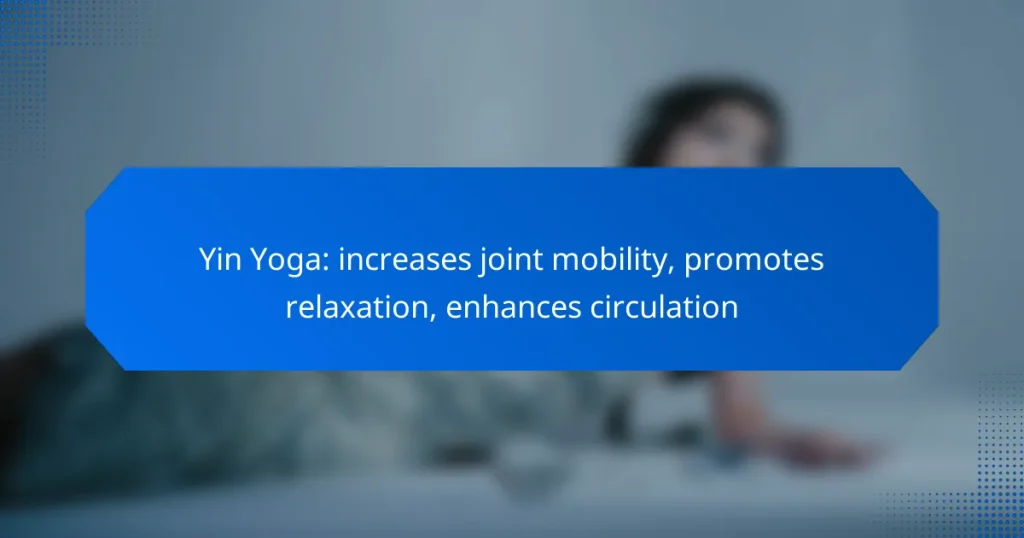Yin Yoga is a gentle practice that increases joint mobility by focusing on deep connective tissues through prolonged postures. It promotes relaxation and enhances circulation, allowing for improved blood flow and nutrient delivery throughout the body. This meditative approach not only releases tension but also fosters a sense of calm and overall well-being.

How does Yin Yoga increase joint mobility?
Yin Yoga increases joint mobility by targeting the deep connective tissues and promoting relaxation through prolonged holds in postures. This practice encourages the body to release tension and enhances the flexibility of joints, which can lead to improved overall movement and comfort.
Stretches connective tissues
Yin Yoga focuses on stretching and stimulating the connective tissues, such as ligaments and fascia, which surround the joints. By holding poses for extended periods, typically between three to five minutes, practitioners allow these tissues to gradually lengthen and become more pliable.
This deep stretching can help alleviate stiffness and tension, making it easier to move freely. Regular practice can lead to increased resilience in connective tissues, reducing the risk of injury during other physical activities.
Improves flexibility
Through consistent practice, Yin Yoga can significantly improve flexibility by encouraging the body to adapt to deeper stretches. The long-held poses allow muscles to relax, which can lead to a greater range of motion in the joints.
For those new to flexibility training, starting with basic poses like the Butterfly or Dragon can be beneficial. Over time, practitioners may find they can achieve deeper stretches, enhancing their overall flexibility and comfort in daily movements.
Enhances range of motion
Yin Yoga enhances the range of motion by promoting the release of tightness in the joints and surrounding muscles. As practitioners hold poses, they engage in mindful breathing, which helps to relax the body and mind, allowing for deeper stretches.
To maximize benefits, it’s advisable to practice Yin Yoga regularly, ideally two to three times a week. This consistency can lead to noticeable improvements in joint mobility and overall physical performance, making everyday activities easier and more enjoyable.

What are the relaxation benefits of Yin Yoga?
Yin Yoga offers significant relaxation benefits by promoting deep stretches that target connective tissues and joints, fostering a state of calm and tranquility. This practice encourages the release of tension, enhances circulation, and helps practitioners achieve a meditative state, ultimately leading to improved overall well-being.
Reduces stress levels
Yin Yoga effectively reduces stress levels by encouraging the body to enter a state of relaxation. The long-held poses stimulate the parasympathetic nervous system, which helps lower cortisol levels and promotes a sense of peace. Regular practice can lead to a more resilient response to daily stressors.
To maximize stress reduction, aim for sessions lasting between 60 to 90 minutes, focusing on poses that open the hips and chest. Incorporating props like bolsters and blankets can enhance comfort and support, allowing for deeper relaxation.
Promotes mindfulness
Yin Yoga promotes mindfulness by encouraging practitioners to focus on their breath and bodily sensations during each pose. This heightened awareness fosters a deeper connection to the present moment, which can alleviate anxiety and enhance emotional regulation. Mindfulness cultivated in Yin Yoga can extend beyond the mat into daily life.
To enhance mindfulness, practice in a quiet environment and limit distractions. Consider setting an intention for your practice, which can guide your focus and deepen your experience.
Encourages deep breathing
Deep breathing is a fundamental aspect of Yin Yoga that enhances relaxation and promotes a sense of calm. As you hold poses, focusing on slow, deep breaths helps to release tension and increase oxygen flow throughout the body. This practice can lead to improved lung capacity and overall respiratory health.
To encourage deep breathing, try inhaling for a count of four and exhaling for a count of six while in each pose. This technique can help regulate your breath and deepen your relaxation experience during your practice.

How does Yin Yoga enhance circulation?
Yin Yoga enhances circulation by promoting deep stretching and relaxation, which helps to increase blood flow throughout the body. This practice targets the connective tissues and joints, allowing for improved oxygen and nutrient delivery to various tissues.
Stimulates blood flow
Yin Yoga poses are held for extended periods, typically ranging from one to five minutes, which encourages blood vessels to expand and contract. This process stimulates blood flow, enhancing the delivery of oxygen and nutrients to muscles and organs. Regular practice can lead to better overall circulation, especially in areas that may feel stiff or tight.
Improves lymphatic drainage
The gentle stretching and prolonged holds in Yin Yoga facilitate lymphatic drainage, which is crucial for removing toxins and waste products from the body. As the lymphatic system relies on muscle movement to function effectively, the slow, mindful movements in Yin Yoga can support this process. Incorporating poses that target specific areas, such as the hips and legs, can further enhance lymphatic flow.
Supports cardiovascular health
By promoting relaxation and reducing stress, Yin Yoga can contribute positively to cardiovascular health. Lower stress levels are associated with reduced blood pressure and improved heart function. Additionally, the increased circulation from Yin Yoga may help to maintain healthy blood vessels, supporting overall heart health.

What are the prerequisites for practicing Yin Yoga?
Practicing Yin Yoga requires a few essential prerequisites to ensure a safe and effective experience. A basic understanding of yoga principles, comfortable clothing, and a quiet environment are key factors that contribute to a successful practice.
Basic understanding of yoga
Having a basic understanding of yoga is crucial before starting Yin Yoga. Familiarity with fundamental poses and breathing techniques can enhance your practice and help you feel more comfortable during sessions. It’s beneficial to know how Yin Yoga differs from other styles, focusing on long-held postures that target deep connective tissues.
Consider attending a few beginner classes or watching instructional videos to grasp the foundational concepts. This knowledge will prepare you for the slower pace and meditative aspects of Yin Yoga.
Comfortable clothing
Wearing comfortable clothing is essential for practicing Yin Yoga, as it allows for ease of movement and relaxation. Opt for breathable, stretchy fabrics that won’t restrict your range of motion. Clothing should also be warm enough to maintain body temperature during longer holds, as the practice often involves staying still for extended periods.
Avoid overly tight or heavy garments that may distract you from your practice. Layers can be helpful, allowing you to adjust your clothing as needed throughout the session.
Quiet environment
A quiet environment is vital for a successful Yin Yoga practice, as it promotes relaxation and mindfulness. Choose a space that is free from distractions, such as loud noises or interruptions. Ideally, this should be a calm area where you can focus on your breath and body sensations.
Consider using soft lighting or candles to create a soothing atmosphere. If possible, play gentle background music or nature sounds to enhance your experience, but ensure it remains at a low volume to maintain tranquility.

What equipment is needed for Yin Yoga?
To practice Yin Yoga effectively, minimal equipment is required, primarily focused on comfort and support. Essential items include a yoga mat, blocks, bolsters, and blankets to enhance your experience and facilitate deeper relaxation.
Yoga mat
A good quality yoga mat provides a stable and comfortable surface for your practice. Look for mats that are thick enough to cushion your joints but not so thick that they compromise stability. Mats with a non-slip surface are ideal for maintaining grip during long-held poses.
When selecting a mat, consider materials that are eco-friendly and free from harmful chemicals. Popular choices include natural rubber or TPE mats, which offer durability and comfort.
Blocks and bolsters
Blocks and bolsters are essential tools in Yin Yoga, helping to support your body in various poses. Blocks can be used to elevate your hips or support your back, making poses more accessible and comfortable. Bolsters provide cushioning and can be placed under the knees or back for added support.
When choosing blocks, opt for lightweight foam or cork options that are easy to handle. Bolsters come in various shapes and sizes, so select one that fits your body and the poses you plan to practice.
Blankets
Blankets are versatile props in Yin Yoga, providing warmth and comfort during long-held poses. They can be rolled up to support the spine or placed under the knees for extra cushioning. A soft, thick blanket can also help you relax more deeply by keeping your body warm.
Consider using a blanket made from natural fibers for breathability and comfort. Having a couple of blankets on hand allows you to adjust your support based on the specific pose or your personal comfort needs.

What are common Yin Yoga poses?
Yin Yoga includes several poses that focus on deep stretching and relaxation, enhancing joint mobility and circulation. Common poses often target the hips, spine, and legs, allowing practitioners to hold stretches for extended periods to promote flexibility and calmness.
Butterfly pose
Butterfly pose, or Baddha Konasana, involves sitting with the soles of the feet together and allowing the knees to drop outward. This pose effectively stretches the inner thighs and groin while promoting relaxation. To practice, sit tall, gently press the knees toward the floor, and lean forward slightly to deepen the stretch.
Hold this position for several minutes, focusing on your breath to enhance the calming effects. Avoid forcing the knees down; instead, let gravity assist the stretch while remaining mindful of any discomfort.
Child’s pose
Child’s pose, or Balasana, is a restorative position that encourages relaxation and gentle stretching of the back and hips. To enter this pose, kneel on the floor, sit back on your heels, and stretch your arms forward while lowering your torso to the ground. This pose is excellent for releasing tension and calming the mind.
Maintain this position for several minutes, breathing deeply to enhance the sense of relaxation. If you experience discomfort in your knees, consider placing a cushion or blanket under them for added support.

